A triple atom catalyst with ultrahigh loading potential for nitrogen electrochemical reduction†
Abstract
One of the key challenges with atomic catalysts (single, double, and triple atom catalysts) is the relatively low loading of active materials, resulting in the low mass or volume activity of catalysts, which hinders their rapid development in the field of catalysis. Herein, using density functional theory (DFT), we explore a series of atomic catalysts with heterostructured substrate, graphdiyne and graphene (GDY/Gra), for the nitrogen reduction reaction (NRR). The theoretical mass loading of active metal atoms can exceed 35.0 wt% in the triple atom catalyst (TAC), which could be reached through the optimal substrate and suitable precursors in experiments. Among the designed atomic catalysts, Fe3-GDY/Gra with a theoretical mass loading of 35.8 wt% shows outstanding catalytic activity for the electrocatalytic NRR with a potential of −0.26 V vs. the reversible hydrogen electrode (RHE). Moreover, the proposed TACs show better catalytic activity for the NRR than single atom catalysts (SACs) and double atom catalysts (DACs) due to the unique properties of M3 (M = Mn, Fe, Co, and Ni) active sites, which provide more electrons for activating N2, but also have a weak adsorption to more easily release products. These findings provide a new strategy for designing atomic catalysts with high loading, high stability, and high activity.



 Please wait while we load your content...
Please wait while we load your content...